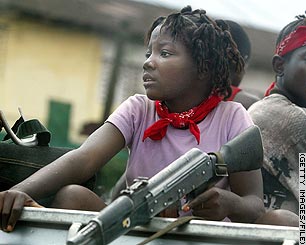Post by Blaque on Feb 12, 2007 14:16:35 GMT -5


CNN) -- Warlords are forcing children in conflicts around the world to become killing machines -- nothing more than what one child advocate calls "cannon fodder."
Some children are kidnapped from their schools or their beds, some are recruited after seeing their parents slaughtered, some may even choose to join the militias as their best hope for survival in war-torn countries from Colombia, and across Africa and the Middle East, to south Asia.
Once recruited, many are brainwashed, trained, given drugs and then sent into battle with orders to kill.
There is no escape for what the United Nations and human rights groups estimate are 250,000 child soldiers today. These children, some as young as 8, become fighters, sex slaves, spies and even human shields.
Sometimes their guns are taller than they are. But the child soldiers can be frighteningly cold and effective, according to CNN Africa correspondent Jeff Koinange. (Audio Slide Show: Koinange describes coming face to face with gun-wielding children)
He said they take macho noms de guerre like "Col. Rambo" and "Brig. Chop Them Up."
"The saddest part is we, as adults, had to address them as such," he added. "Otherwise you just never knew what would happen." (Read Koinange recall how child soldiers killed his friend)
The children's very vulnerability makes them attractive to the men leading militias, according to Jo Becker, who has interviewed former child soldiers in Sri Lanka, Nepal, Uganda and Myanmar for Human Rights Watch.
They are easy to manipulate and will do the unspeakable without question or protest, partly because their morals and value systems are not yet fully formed, she said. In some cultures, child soldiers -- 40 percent of whom can be girls -- are considered expendable "cannon fodder," she said.
Ordered not to cry
The journey from boy or girl to killing machine follows a horrifying route of indoctrination, including being forced to execute friends and family, international organizations report.
One girl, Angela, 12, told Human Rights Watch she was told to shoot a friend when she joined Colombia's FARC guerrillas. (Watch children drilled for war in the mud )
"I closed my eyes and fired the gun, but I didn't hit her. So I shot again," she said. "I had to bury her and put dirt on top of her. The commander said, 'You'll have to do this many more times, and you'll have to learn not to cry.' "
An indictment against Congolese warlord Thomas Lubanga Dyilo asserts that one of his commanders threatened to shoot a 13-year-old girl unless she tied the testicles of a prisoner with wire. She complied and the captive died.
In Myanmar -- formerly known as Burma -- a boy who was 11 when he was recruited to the national army, had to watch as older soldiers gunned down mothers and then killed their babies. "They swung them by their legs and smashed them against a rock. I saw it," Kim Muang Than told Human Rights Watch.
Changing times
Officials with the United Nations, UNICEF and human rights groups said they are seeing promising signs, 20 years after the United Nations first addressed the issue. (Watch children flee the horror of militia kidnappers )
Child soldiers were on the agenda for a U.N. Security Council working committee Friday. The committee discussed how rebel groups in Nepal and Sri Lanka use children to fight. Action against militias in the Ivory Coast and the Democratic Republic of Congo was also considered.
Last week, 58 countries and nongovernmental agencies signed a treaty to do more to free current and potential child soldiers from peril. And, on January 29, the International Criminal Court forged ahead with its first war crimes prosecution, targeting Lubanga on charges of recruiting child soldiers The act was declared a war crime when the ICC was established in 2002.
"In the past there haven't been consequences against the commanders," said Becker, of Human Rights Watch. "This sends a signal to the groups that the world is paying attention now, you can be jailed for life and your assets can be frozen."
"I think we've come a long way," said Radhika Coomaraswamy, the United Nations' envoy for children and armed conflict. "Ten years ago this was an invisible issue."
Since last summer, groups in Burundi, Ivory Coast, Myanmar, the Democratic Republic of the Congo, Sudan and Somalia have been referred to the U.N. Security Council for possible sanctions.
But there are many, many more. Child soldiers have been used in the past decade in more than 30 countries, according to the United Nations, Amnesty International and Human Rights Watch, which said young fighters were active in at least 19 countries last year. (Map: Where children are forced to fight)
Coomaraswamy sees the Middle East, Sudan's Darfur and eastern Chad as the new trouble spots. (Read about Iraq's child soldiers)
There are also concerns in Asia, with Human Rights Watch posting reports in January alleging violations by Maoist forces in Nepal and an offshoot of the Tamil Tigers rebel group in Sri Lanka.
"We're no longer just pointing fingers at rebel groups or government armies," said Human Rights Watch's Becker. "Now we're holding individual commanders accountable for their crimes."
U.N. envoy Coomaraswamy is taking an optimistic long view. "I think this is a little bit like the campaign against slavery in the late 19th century," she said. "There's such an abhorrence of it on an international level."
But much remains to be done, she cautioned. Funds must be found and steps taken to restore some sense of normal life for children numbed and hardened by their war experiences. In many cases, she said, their families don't want them and they are shunned by villagers.
Abandoned, they find little to eat, have nothing to do and scant hope for the future, Coomaraswamy said.
Without intervention, they could grow up to become a lost generation of migrant professional killers.



